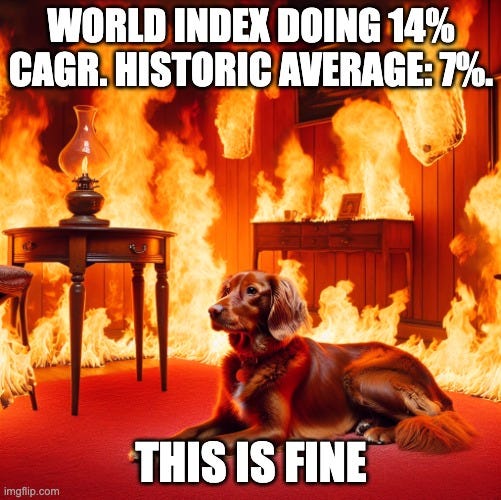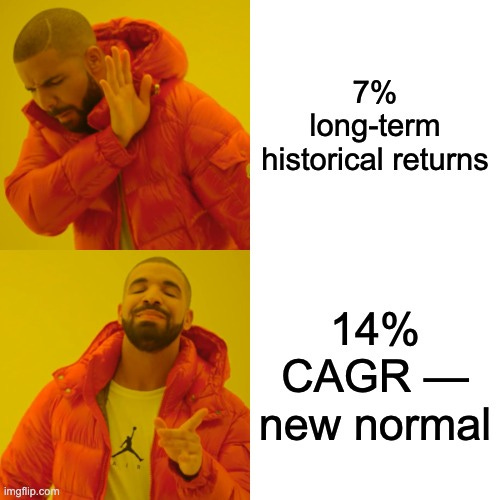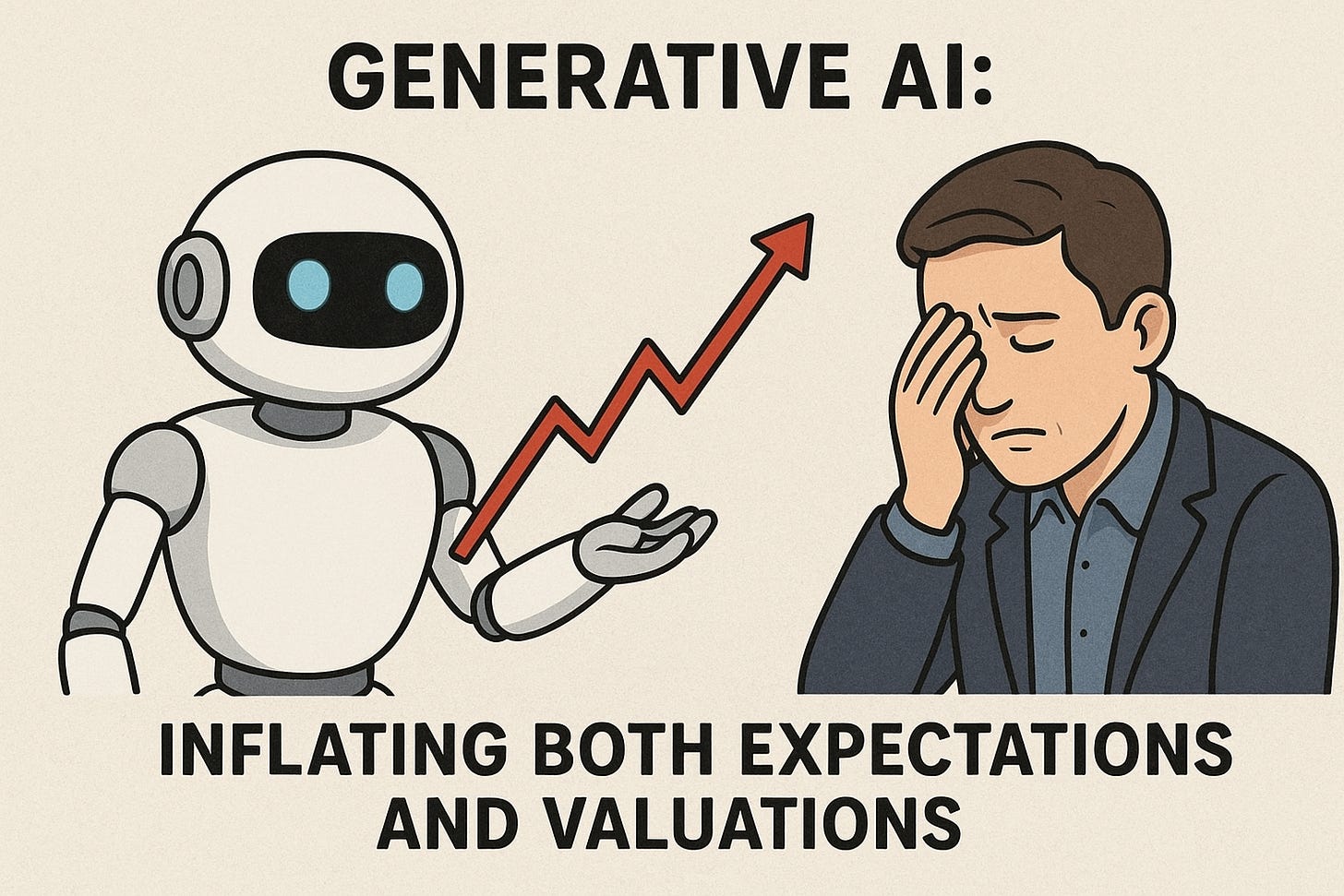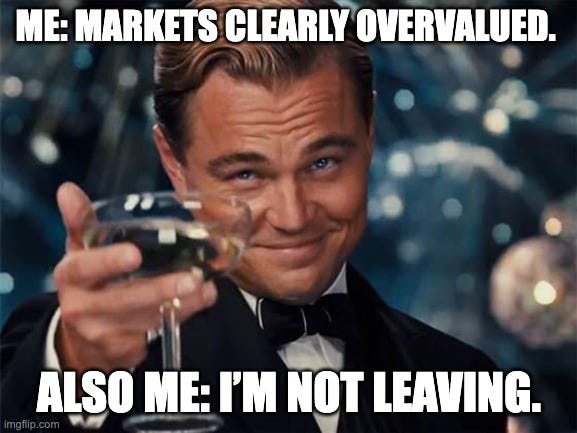Borrowed Time, Borrowed Returns
What history reminds us when markets sprint too far ahead
I reported my portfolio’s performance in the last post, noting that it earned 13% since inception (Jan 1, 2023) - about 9% in real terms - yet it has slightly underperformed the World Tracker Index, which clocked a 14% CAGR over the same period.
Let’s start with the obvious question: is a 14% nominal / 9% real return a reasonable outcome for a global stock index over three years?
Historically, the best-performing markets (think India and the US) have delivered around 8.5–10% annualized USD returns over long horizons - say, 30 years. For context, the MSCI World Index has returned 7.03% nominally (and roughly 4.5% in real terms) over the past 21 years.
So, realistically, we shouldn’t expect a global tracker to compound much beyond 7% nominal / 4.5% real over time. Yet, here we are with far higher returns in the recent three-year stretch. What’s driving this? And what comes next?
One caveat: my base year is end-2022, when both the CCP and this blog began. Markets were deeply depressed after a bruising 2022, so the subsequent rebound makes sense. We’re merely catching up to where we might have been had 2022 not been such a washout - simply tracking the historical trend since, say, 2012. That explanation holds water. But does it really?
Let’s zoom out. If we roll back to November 2016, when the Vanguard Global Tracker Fund launched, it has compounded at 11% CAGR (GBP) since then - still comfortably above historical norms. So, something else must be at play.
At the end of 2022, after the market had punished “non-profitable” firms and the speculative froth - SPACs, meme stocks, NFTs, meme-coins - had deflated, I expected a return to sanity. That hasn’t quite materialized. Why?
Ocaam’s Razor points squarely at the rise of Generative AI - a distinctly new phase in the technological cycle. I recently read that nearly all of U.S. GDP growth in 2025 could be attributed to AI datacenter buildouts. That’s staggering.
Modern AI (think Generative AI, as opposed to prior eras of machine learning and statistical AI) only burst onto the scene in 2022 - yet it has gathered exponential momentum, both in capability and in capital flow. Investment, revenue, valuation - all off the charts.
But the AI argument cuts both ways.
On one hand, AI could be ushering in a new era of productivity and prosperity - perhaps justifying structurally higher returns. Maybe 13% nominal / 9% real is the new normal
On the other, we might be pouring trillions in capex into infrastructure whose returns on capital lag the prior generation’s tech plays (OS, Cloud, SaaS). In that scenario, ROCE compresses and returns stagnate as excess capital burns off. Both stories sound plausible.
Then there’s the inflation-interest rate dynamic. In an inflationary world, company revenues rise nominally (they sell the same goods at higher prices). But that’s sustainable only if interest rates stay artificially low - as they did in 2020–21 when governments were effectively helicoptering money. Sound economics dictates that high inflation demands high interest rates, which, in turn, normalizes real returns.
Are there other big dimensions? Possibly. But let’s circle back.
The real point I’m making is this: none of these explanations seem strong enough to justify a permanent break from historical return norms. If we exclude that possibility, we’re left with a less cheerful conclusion - that markets are over-earning today, and this phase won’t last indefinitely. I don’t know when the turn comes, but absent a credible reason for a long-term step-up in returns, mean reversion is inevitable.
Now that the theoretical spiel is out of the way - humour me. Even if you’re a raging market bull: what does this imply for us? Is there a way to hedge it?
If you could predict both the event and the timing, it’s easy: buy PUTs, cash them in post-event, and retire on a beach - Portugal, aí vou eu!
But if you only sense the event and not its timing, options become an expensive drag. (One-year at-the-money PUTs cost roughly 8–10%, depending on the index.) Alternatively, you could go defensive - but that depresses returns, and if the correction takes longer than expected, you lose more waiting than in the drawdown itself.
I don’t have a silver-bullet strategy - but I’m certainly spending more time thinking about it than before.
If you’ve got ideas, drop them in the comments. I’d love to hear them.
Happy Investing!!
Disclaimer: I am not your financial advisor and bear no fiduciary responsibility. This post is only for educational and entertainment purposes. Do your own due diligence before investing in any securities. I may hold or enter into, a position in any of the stocks mentioned above. The above is NOT a solicitation to either buy or sell the securities listed in this post.





